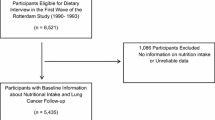Abstract
This hospital-based case-control study was designed to investigate the association of low dietary vitamin A and beta carotene consumption with epidermoid lung cancer. Cases were patients with histologically confirmed epidermoid lung cancer diagnosed in six selected hospitals of south-western France in 1983–84. Controls were selected from patients admitted to the same hospitals during the same period with diagnoses other than cancer. Cases and controls were matched for sex, age, place of residence, occupation, professional exposure to carcinogens, tobacco and alcohol consumption. A total of 106 cases of epidermoid lung cancer and 212 controls were interviewed on their typical weekly intake of 80 food items rich in preformed vitamin A and beta carotene. Index measures of the vitamin A and beta carotene daily intakes were computed for each individual patient and expressed in retinol equivalent (RE). A statistically significant odds ratio (OR) was found for preformed vitamin A (OR=4.3; 95% CI: 2.5–7.3) with the threshold of 1,000 RE. A similar result was found for beta carotene with the same threshold (OR = 4.1; 95% CI: 2.3–7.4). Using the conditional logistic regression, consumption of preformed vitamin A and consumption of beta carotene were significantly and independently associated with epidermoid lung cancer. While confirming the protective role of beta carotene against epidermoid lung cancer, this study also shows that preformed vitamin A might have a distinct and important protective effect.
Similar content being viewed by others
References
Anonymous (1979): Vitamin A, tumor initiation and tumor promotion (Editorial) - Nutr. Rev. 37:153–156.
BirtD.F. (1986): Update on the effects of vitamins A, C, and E and selenium on carcinogenesis - Proc. Soc. Exp. Biol. Med. 183: 311–320.
BreslowN.E. (1982): Covariance adjustement of relative risk estimates in matched studies -Biometrics 38: 661–672.
BreslowN.E., DayN.E., HalvorsenK.T. et al. (1978): Estimation of multiple relative risk functions in matched case-control studies - Am. J. Epidemiol. 108: 299–307.
ByersT.E., GrahamS., HaugheyB.P. et al. (1987): Diet and lung cancer: findings from the Western New-York diet study - Am. J. Epidemiol. 125: 351–363.
ColditzG.A., StampferM.J. and WilletW.C. (1987): Diet and lung cancer. A review of the epidemiologic evidence in humans - Arch. Intern. Med. 147: 157–160.
CubeauJ. and PequignotG. (1980): La technique du questionnaire alimentaire utilisé par la section nutrition de l'INSERM- Rev. Epidemiol. Santé Publ. 28: 367–372.
FleissJ.L. (1984): The Mantel-Haenszel estimator in case control studies with varying numbers of controls matched to each case - Am. J. Epidemiol. 120: 1–3.
GoodmanD.W. (1984): Vitamin A and retinoids in health and disease - N. Engl. J. Med. 310: 1023–1031.
HarisisiadisL., MillerR.C., HallE.J. et al. (1978): Vitamine A analogue inhibits radiation-induced oncogenic transformation - Nature 274: 486–487.
HarrellF.E. (1983): The PHGCM Procedure in SUGI supplemental library user's guide - 1983 edition SAS Institute Inc., Cary, NC.
HindsM.W., KolonelL.N., HankinJ.H. et al. (1984): Dietary vitamin A, carotene, vitamin C and risk of lung cancer in Hawaii - Am. J. Epidemiol. 119: 227–237.
HumbleC.G., SametJ.M. and SkipperB.E. (1987): Use of quantified and frequency indices of vitamin A intake in a case-control study of lung cancer - Int. J. Epidemiol. 16: 341–346.
MenkesM.S., ComstockG.W., VuilleumierJ.P. et al. (1986): Serum beta-carotene, vitamins A and E, selenium and the risk of lung cancer - N. Engl. J. Med. 315: 1250–1254.
OstrowskiZ.L. (1978): Les aliments: table des valeurs nutritives. Association Européenne pour l'Etude et le Développement de l'Enfant - Gilanor ed., Paris.
PisaniP., BerrinoF., MacalusoM. et. al. (1986): Carrots, green vegetables and lung cancer: a case-control study - Int. J. Epidemiol. 15: 463–468.
PrenticeR.L. and BreslowN.E. (1978): Retrospective studies and failure time models - Biometrika 65: 153–158.
SametJ.M., SkipperB.J., HumbleC.G. et al. (1985): Lung cancer risk and vitamin A consumption in New Mexico - Am. Rev. Respir. Dis. 131: 198–202.
SantamariaL., BianchiA., ArnoboldiL. et al. (1983): Dietary carotenoids block photocarcinogenic enhancement by benzopyrene and inhibits its carcinogenesis in the dark - Experientia 39: 1043–1045.
ShekelleR.B., RaynorJr.W.J., LepperM. et al. (1981): Dietary vitamin A and risk of cancer in the Western Electric Study - Lancet ii: 1185–1190.
ZieglerR.G., MasonT.J., StemhagenA. et al. (1986): Carotenoid intake, vegetables and the risk of lung cancer among withe men in New Jersey - Am. J. Epidemiol. 123: 1080–1093.
Author information
Authors and Affiliations
Rights and permissions
About this article
Cite this article
Dartigues, J.F., Dabis, F., Gros, N. et al. Dietary vitamin A, beta carotene and risk of epidermoid lung cancer in South-Western France. Eur J Epidemiol 6, 261–265 (1990). https://doi.org/10.1007/BF00150430
Issue Date:
DOI: https://doi.org/10.1007/BF00150430



